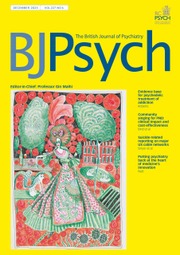The inclusion of gaming disorder in ICD-11 as a new addictive behaviour was supported by epidemiological estimates, which have implied such psychiatric problems to be globally prevalent.Reference Reed, First, Billieux, Cloitre, Briken and Achab1 After nosological criteria for diagnosing gaming disorder were proposed in DSM-5 and ICD-11, studies have collected further epidemiological evidence by using more diagnostically consistent self-report measures across countries and populations.Reference Karhulahti, Martončik and Adamkovič2 According to recent meta-analyses that include mixed measures, the global prevalence of gaming disorder is 2–3%.Reference Kim, Son, Roh, Ahn, Kim and Shin3 This letter reports a sequence of events that can significantly affect the interpretation of such epidemiological rates.
As part of the participant recruitment for our longitudinal research, we surveyed the general Finnish population to identify people who have sought clinical treatment for gaming disorder symptoms. Gaming disorder criteria from ICD-11 were used for pre-screening. We contacted 44 people who self-reported treatment-seeking due to gaming, 7 of whom replied and expressed interest in joining the study. In the entrance interview with a clinician, however, it turned out that six out of the seven people had sought treatment not for gaming but for gambling.
This led us to closely reinvestigate the content of validated gaming disorder measures, which are based on DSM-5, ICD-11 and other nosological systems. Surprisingly, we did not find any of the validated English DSM-5 and ICD-11 based gaming disorder self-report measuresReference Karhulahti, Martončik and Adamkovič2 nor those listed as the most used measuresReference Kim, Son, Roh, Ahn, Kim and Shin3 to have items or instructions that would exclude gambling. Because these measures ask about behaviours in digital games (i.e. computer games, internet games, video games) and many gambling products are also digital games, people with symptoms of gambling disorder can also meet the criteria of measures for gaming disorder.
The above has not been a problem in gambling measurement because gaming conceptually includes gambling, but not vice versa: in English, all gambling is gaming but not all gaming is gambling (Fig. 1). In other languages the clinical associations between gambling and gaming terminologies varyReference Castrén, Salonen, Alho and Lahti4 and would benefit from systematic global assessment.

Fig. 1 Conceptual overlap between gaming and gambling in English.
Our findings imply that most, if not all, epidemiological estimates of gaming disorder combine both gaming and gambling prevalence rates. Considering that the global prevalence of clinical gambling problems has been estimated to be 0.12–5.8%,Reference Calado and Griffiths5 the present finding should encourage researchers to critically reconsider the current epidemiological knowledge produced by gaming disorder self-report measures and meta-analyses. This can also help explain previously found correlations between gaming- and gambling-related health problems.Reference Spicer, Nicklin, Uther, Lloyd, Lloyd and Close6
Next, researchers should carefully investigate the prevalence of efforts to exclude gambling from gaming disorder measurement across languages, populations and specific scales to produce more reliable epidemiological estimates. This will be helpful to further improve both policy and practice globally as well as regionally. The developers of new gaming disorder screening measures should, by default, include instructions or items that explicitly tell participants not to report their gambling behaviours.
Data availability
The data generated with participants who consented to be studied are currently being made accessible for research purposes in the Finnish Social Science Data Archive.
Author contributions
V.M.K. wrote the original draft and is responsible for coordinating the project on which this letter is based. T.A. contributed revisions to the original draft and served as the clinician in the entrance interviews.
Funding
Funded by the European Union (ERC 101042052). Views and opinions expressed are however those of the author(s) only and do not necessarily reflect those of the European Union or the European Research Council. Neither the European Union nor the granting authority can be held responsible for them.
Declaration of interest
None.




eLetters
No eLetters have been published for this article.